|
 Although it looks a lot like the
Lockheed P-38 Lightning,
Hughes Aircraft's F-11 was designed to be an aerial photo-reconnaissance platform during
World War II, and was much larger than the P-38. Eccentric millionaire and accomplished
aviator Howard Hughes served as the test pilot for the
XF-11 prototype,
which ended up crashing into a couple houses just outside the airport (shown in "The Aviator" movie). Only two were ever built. Interestingly, somewhere
I have an article in either an American Modeler or another Air Trails
magazine what tells the tale of pilot who during World War II used a specially equipped
P-38 to take low level, high speed flight photographs of German troop movements along
the western side of the English Channel in the run-up to the D-Day invasions. That story
will be published here on Airplanes and Rockets as soon as I find it. Although it looks a lot like the
Lockheed P-38 Lightning,
Hughes Aircraft's F-11 was designed to be an aerial photo-reconnaissance platform during
World War II, and was much larger than the P-38. Eccentric millionaire and accomplished
aviator Howard Hughes served as the test pilot for the
XF-11 prototype,
which ended up crashing into a couple houses just outside the airport (shown in "The Aviator" movie). Only two were ever built. Interestingly, somewhere
I have an article in either an American Modeler or another Air Trails
magazine what tells the tale of pilot who during World War II used a specially equipped
P-38 to take low level, high speed flight photographs of German troop movements along
the western side of the English Channel in the run-up to the D-Day invasions. That story
will be published here on Airplanes and Rockets as soon as I find it.
F-11 / XF-11
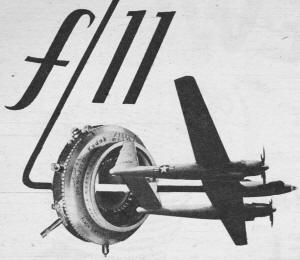 This sleek, twin-engine, twin-boom airplane,
especially designed for photo-reconnaissance work, is a product of Hughes Aircraft Corp.,
Culver City, Calif., and was pretty much of a hush-hush project for a while. It burst
into the limelight when its prototype, equipped with eight-bladed contra-rotating propellers,
crashed during one of the trial flights with Howard Hughes acting as test pilot. The
accident was due to a sudden reversal of pitch of the rear right propeller unit which
imposed such a severe yaw on the airplane that it became uncontrollable. Hughes miraculously
escaped death but was laid up in hospital for several months. As a consequence, the second
prototype, illustrated here, now undergoing test flights at Wright Field, has conventional,
four-bladed, Curtiss electric reversible-pitch propellers. The plane is of all-metal
construction with a wing span of 101 ft. 4 in., and a length of 65 ft. 5 in. Weight empty
is: 37,200 lbs., gross weight 47,500 lbs. It is powered by two Pratt & Whitney R-4360-37,
28-cylinder engines developing in excess of 3000 hp at take-off. Maximum speed is in
the neighborhood of 425 mph, service ceiling is 44,000 feet, and range is 5000 miles.
An interesting feature of the XF-11 are the spoiler ailerons like the ones used on the
Northrop P-61. This permits use of full span flaps on the wing with the result that the
plane stalls at only 80 mph. The XF-11 carries a crew of two, seated side-by-side in
a pressurized cockpit, second member acting as co-pilot, camera operator, and navigator.
The slim fuselage nacelle houses up to eight aerial cameras which can be operated either
from the Plexiglas nose or the cockpit. This sleek, twin-engine, twin-boom airplane,
especially designed for photo-reconnaissance work, is a product of Hughes Aircraft Corp.,
Culver City, Calif., and was pretty much of a hush-hush project for a while. It burst
into the limelight when its prototype, equipped with eight-bladed contra-rotating propellers,
crashed during one of the trial flights with Howard Hughes acting as test pilot. The
accident was due to a sudden reversal of pitch of the rear right propeller unit which
imposed such a severe yaw on the airplane that it became uncontrollable. Hughes miraculously
escaped death but was laid up in hospital for several months. As a consequence, the second
prototype, illustrated here, now undergoing test flights at Wright Field, has conventional,
four-bladed, Curtiss electric reversible-pitch propellers. The plane is of all-metal
construction with a wing span of 101 ft. 4 in., and a length of 65 ft. 5 in. Weight empty
is: 37,200 lbs., gross weight 47,500 lbs. It is powered by two Pratt & Whitney R-4360-37,
28-cylinder engines developing in excess of 3000 hp at take-off. Maximum speed is in
the neighborhood of 425 mph, service ceiling is 44,000 feet, and range is 5000 miles.
An interesting feature of the XF-11 are the spoiler ailerons like the ones used on the
Northrop P-61. This permits use of full span flaps on the wing with the result that the
plane stalls at only 80 mph. The XF-11 carries a crew of two, seated side-by-side in
a pressurized cockpit, second member acting as co-pilot, camera operator, and navigator.
The slim fuselage nacelle houses up to eight aerial cameras which can be operated either
from the Plexiglas nose or the cockpit.
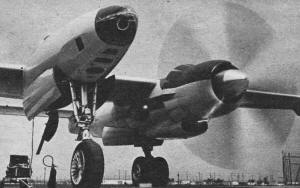 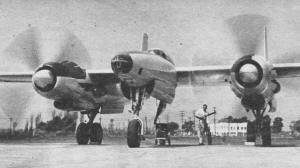
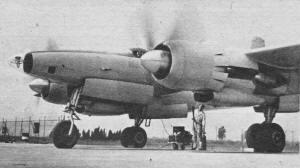 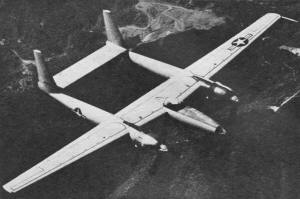
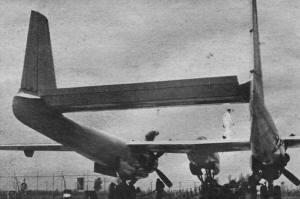
Posted March 7, 2015
|


